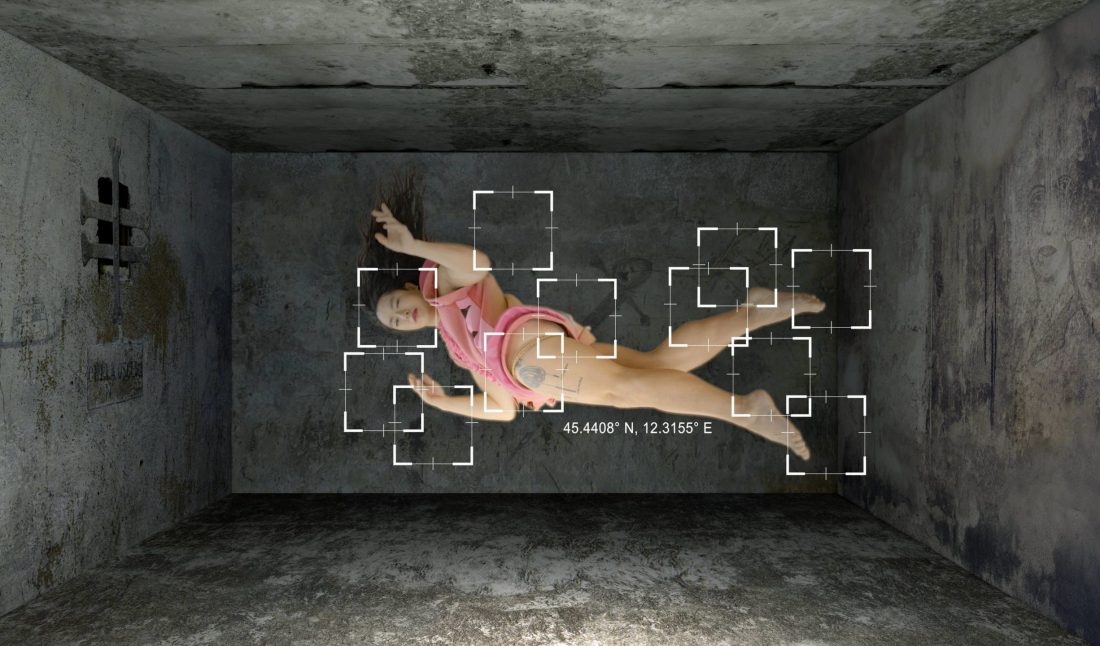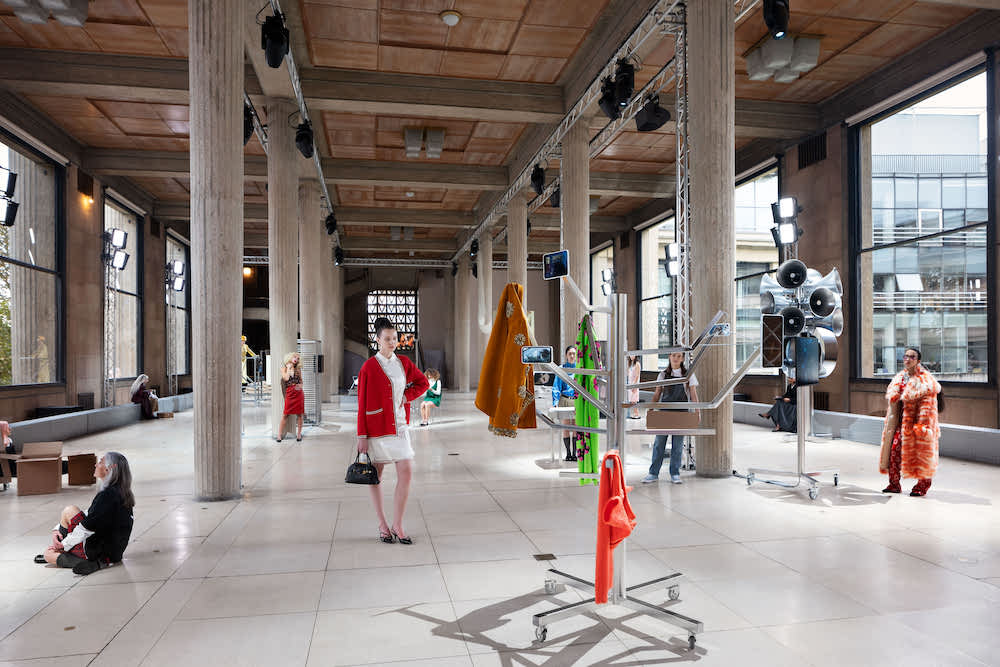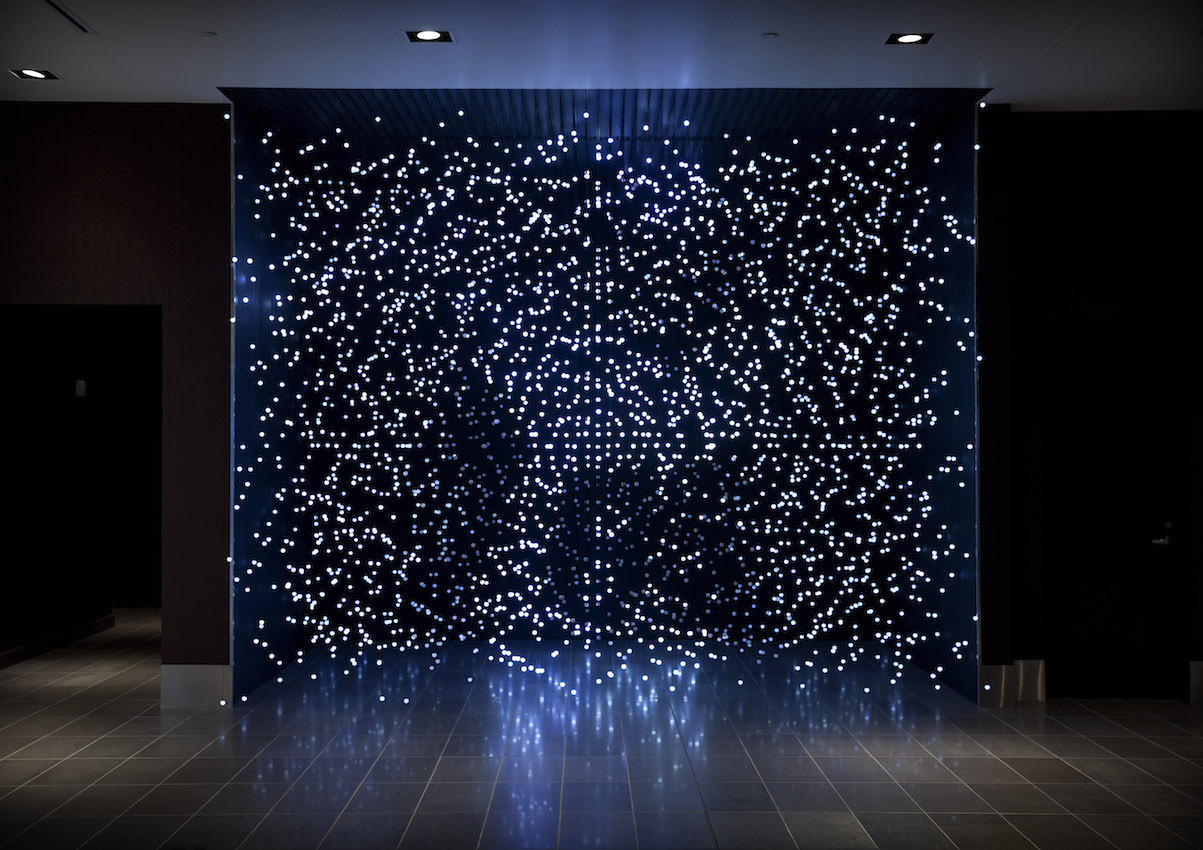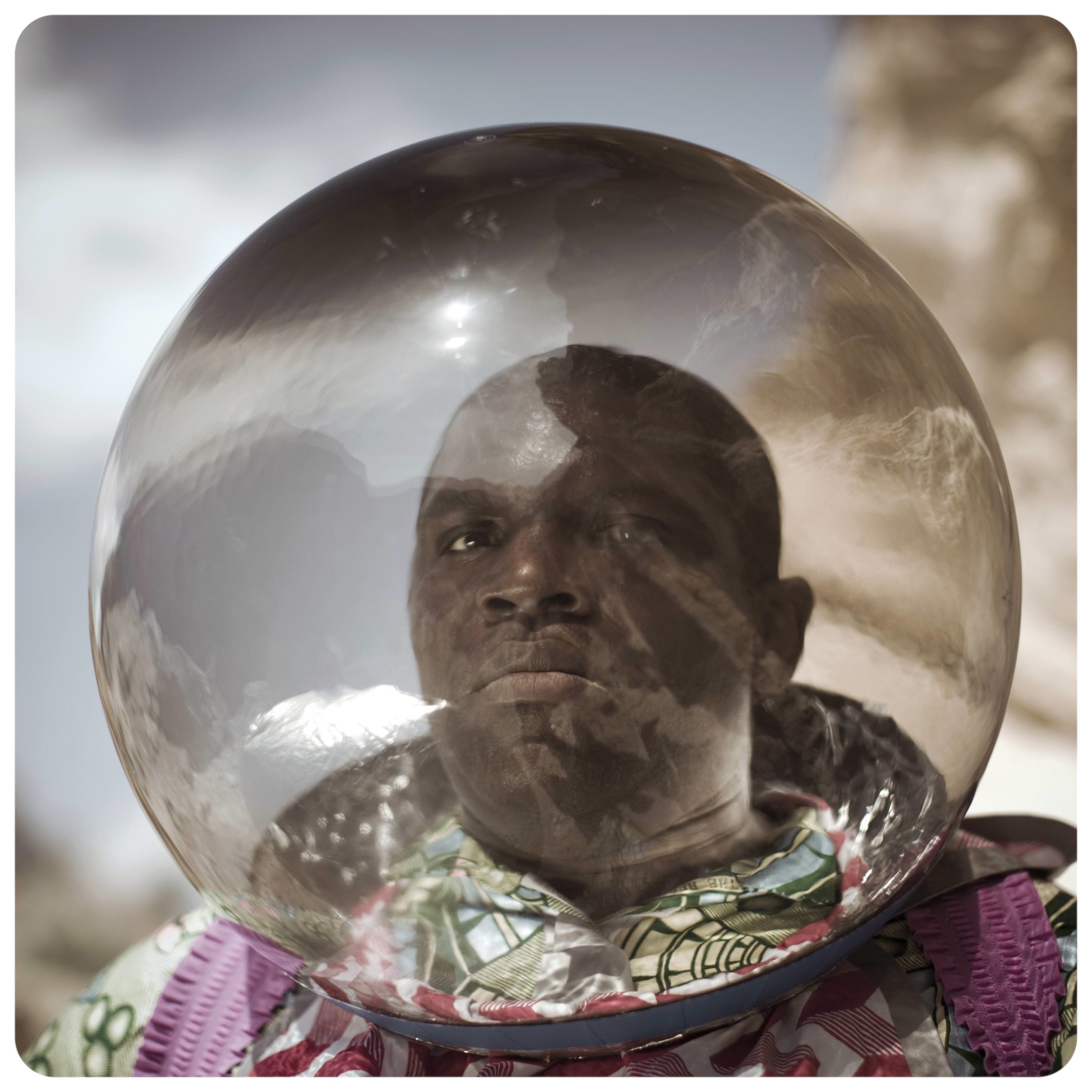On May 11, the 58th Biennale Arte kicks off in Venice, remaining open to visitors through November 24. Curated by Ralph Rugoff, this year’s edition (entitled “May You Live in Interesting Times”) presents 91 international exhibitors and 79 artists from all over the world, displayed across the Giardini and Arsenale.
AUSTRIA
Renate Bertlmann
Curated by: Felicitas Thun-Hohenstein
Renate Bertlmann is the first woman to represent Austria with a solo exhibition at the Venice Biennale in its decades-long history. Bertlmann, an avant-garde artist who explores the relationship between masculine and feminine forms, has long been regarded as a leading feminist artist and a pioneer of performance art. She explores representations of roles and bodies, questioning gender relationships by discussing subjects like pornography, sexuality, violence, Eros, and hierarchy. In one work, for example, a woman, baring armpit hair, struggles while newspaper print covers her face, in a poignant commentary on societal expectations, gender identification, and violence.
BRAZIL
Bárbara Wagner and Benjamin de Burca
Curated by: Gabriel Pérez-Barreiro
Although its production began in late 2018, the film Swinguerra germinated in 2015 during Bárbara Wagner and Benjamin de Burca’s research for their first audiovisual work, Faz que vai (Set to Go) (2015). It was then that they encountered the eponymous trend—swingueira—which emerged out of Recife as a series of large dance groups that culminate in rigorous competitions. To Wagner and de Burca, these systems of dance, which are practiced independently and in collaboration, demonstrate an experience of identity, integration, and spectacle that is simultaneously within and beyond the mainstream. The Brazilian Pavilion will be transformed into an installation inspired by Swinguerra.
CANADA
Isuma
Curated by: Asinnajaq, Catherine Crowston, Barbara Fischer, Candice Hopkins, and Josée Drouin-Brisebois
Isuma—meaning “to think, or a state of thoughtfulness” in Inuktitut—was established in 1990 as Canada’s first Inuit-owned independent production company. Adapting experimental film to Inuit storytelling, Isuma is the next step in a long tradition of oral history, where, as Zacharias Kunuk puts it, “nothing is written down—everything is taught by what you see. Your father’s fixing up the harpoon; you watch how he does it and you learn from it.” Isuma’s videos gesture to an unarchivable visual history and uniquely feature indigenous languages, producers, directors, actors, and writers.
CHILE
Voluspa Jarpa
Curated by: Agustín Pérez Rubio
The Chilean Pavilion confronts Eurocentric approaches to historical narration in a presentation that mimics their milestones and semiotics. The pavilion will feature a museographic environment, a gallery space, and an immersive video that revise viewpoints of colonizer and colonized, reconfigure hegemonic models, and reject the otherness of European stereotypes. Voluspa Jarpa describes her work as a “decolonization exercise.” She based the project on her experience reviewing declassified files of the American secret service involvement in Latin America in the 20th century.
CZECH REPUBLIC
Stanislav Kolíbal
Curated by: Dieter Bogner
Stanislav Kolíbal (born 1925 in Orlová, former Czechoslovakia) is a pioneer of the Czech avant-garde. The exhibition “Former Uncertain Indicated” presents Kolíbal’s artistic work in a semi-retrospective way that includes a site specific intervention. It combines an exterior “spatial drawing” related to the modernist facade of the Czech and Slovak Pavilion and a large-scale “wall drawing” inside the building, both made for this occasion, with two historical bodies of work: a group of white sculptures from the 1960s and four conceptual wall-installations from the 1970s, made of found materials.
DENMARK
Larissa Sansour
Curated by: Nat Muller
The Danish-Palestinian artist Larissa Sansour takes a multidisciplinary approach to her work—fusing film, photography, installation art, and sculpture. Often, she manipulates these vocabularies to develop science fiction universes that echo and question issues of Israeli-Palestinian displacement. On her selection, Lisette Vind Ebbesen, chair of the Danish Arts Foundation, stated, “Good art functions as a trigger for conversations, and we believe that Larissa Sansour achieves precisely that in a deeply affecting way in her art.”
ESTONIA
Kris Lemsalu
Curated by: Andrew Berardini, Irene Campolmi, Sarah Lucas, and Tamara Luuk
Abandoning more overt engagement with death, “FUNTAIN” bares a washed-out
millennial pink mise-en-scène with an artificial lake. Unknown hands grope its exterior while a confrontation takes place within, wrapped up in Technicolor coatings. Lemsalu’s transportive, energetic work combines techniques and methods from ceramics, installation, and performance art—this time, in an effort to make you smile, before you think.
FINLAND
Miracle Workers Collective
Curated by: Bonaventure Soh Bejeng Ndikung, Giovanna Esposito Yussif, and Christopher Wessels
Commissioned by Frame Contemporary Art Finland, the Pavilion of Finland at the 58th Venice Biennale will host the Miracle Workers Collective. Its founding members—curator Bonaventure Soh Bejeng Ndikung, artist and activist Outi Pieski, curator Giovanna Esposito Yussif, curator Christopher Wessels, and spatial designer Lorenzo Sandoval—promise to reimagine the pavilion as a space of discourse, negotiation, aesthetics, and ethics in an imaginative investigation of miracles and moments of impossibility.
FRANCE
Laure Provost
Curated by: Martha Kirszenbaum
Three themes provide the structure for Laure Provost’s French Pavilion: reflection, disconnection, and escapism. Titled “DEEP SEE BLUE SURROUNDING YOU / VOIS CE BLEU PROFOND TE FONDRE,” the project challenges the common dream of a fluid, global world. Imagined as “a metaphorical immersion” into an octopus-like creature, a fictional film (to be accompanied by a sculptural installation) recounts a road trip from the North of France to Venice, in which dialogue builds the concept of “liquid modernity”—the idea that our constantly evolving world will soon be governed by immediacy.
GEORGIA
Anna K.E.
Curated by: Margot Norton
REARMIRRORVIEW, Simulation is Simulation, is Simulation, is Simulation… is a large-scale architectural environment tackling the inherently unstable facades and mythologies that unite us. Drawing on a choreographic instinct developed as a ballerina, Anna K.E. created a multidimensional, reflective landscape of rising plateaus, videos, and sculptures that speak to many of the motifs occupying her larger oeuvre. Punctuating the installation will be sculptures that spell “deranged” in the original Georgian alphabet Asomtavruli, a reference to our own unhinged reality that has become decidedly commonplace.
GERMANY
Natascha Süder Happelmann
Curated by: Franciska Zólyom
The Berlin-based artist Natascha Süder Happelmann fuses installation, performance, sound, text, and extensive research to question our complicity in political structures—though, at the press announcement, it would have been hard to know. Née Natascha Sadr Haghighian, Happelmann intentionally misspelled her name and, at the event, hid her head under a papier-mâché rock. To arrive at Happelmann, Haghighian merged misspellings of her name from the course of her public life, referencing the forced assimilation brokered by our names. Her project for the Biennale, kept quiet for months, will engage with concepts of migration, ruinous spaces, witnessing, and accountability.
GHANA
“Ghana Freedom”
Curated by: Nana Oforiatta Ayim
This year marks the first Ghana Pavilion at the Biennale Arte, and it will take place under the patronage of Ghana’s president, Nana Addo Dankwa Akufo-Addo. Titled after the E. T. Mensah song composed before the nation’s 1957 independence, “Ghana Freedom” follows the legacy of freedom as navigated by six artists from three different generations. Connected by the space’s design, the artists will examine their national culture as well its diasporas: El Anatsui and Ibrahim Mahama will do so in installations, photographer Felicia Abban and painter Lynette Yiadom-Boakye in portraiture, and John Akomfrah and Selasi Awusi Sosu in a film projection and video sculpture, respectively. The pavilion is designed by architect Sir David Adjaye.
GREAT BRITAIN
Cathy Wilkes
Curated by: Dr. Zoe Whitley
Cathy Wilkes graduated with a BA from The Glasgow School of Art in 1988 and completed her MFA at the University of Ulster, Belfast in 1992. Wilkes has produced an outstanding and unique body of work spanning 25 years, and she is widely acknowledged as one of the most influential artists working in the U.K. In 2016, she was the inaugural recipient of the Maria Lassnig Prize and presented the largest solo exhibition of her work to date at MoMA PS1, New York (2017–2018). Dr. Zoe Whitley, senior curator at the Hayward Gallery, London, will curate this year’s exhibition at the British Pavilion, following an open call selection process by the British Council, the pavilion’s commissioners.
HONG KONG
Shirley Tse
Curated by: Christina Li
Shirley Tse’s exhibition, “Stakeholders,” will reflect on negotiation and coexistence in conflict-ridden times, through site-specific sculpture and large scale works. Referencing botany and dendrochronology, parts of her work have been described in naturalistic terms, like the underground roots of a plant. Sprawling throughout the indoor gallery spaces, the spatial intervention of the Negotiated Differences installation will explore the concept of “horizontality,” and the second installation, Playcourt in the outdoor courtyard, will resemble a badminton court and consider the idea of “verticality.” They will feature 3D printed joints and hand-turned wooden forms, as well as amalgams of equipment and anthropomorphic forms.
ICELAND
Hrafnhildur Arnardóttir / Shoplifter
Curated by: Birta Guðjónsdóttir
The trademark material of Hrafnhildur Arnardóttir / Shoplifter is hair. In “Chromo Sapiens,” she will again use this visceral, tactile material to envelop viewers in a multisensory environment. Working with curator Birta Guðjónsdóttir, Shoplifter will transform a warehouse into a cavernous and textured environment that raises pertinent questions about our societal obsession with beautification. Alluring and eerie, “Chromo Sapiens” includes a specially commissioned sound work by the Icelandic metal band HAM.
IRAQ
Serwan Baran
Curated by: Tamara Chalabi and Paolo Colombo
For the fourth National Pavilion of Iraq commissioned by the Ruya Foundation, the Iraqi-Kurdish artist Serwan Baran will probe the notion of “Fatherland” and how it has been deployed to justify warfare. Through large-scale, site-specific, and sculptural works, Baran will interrogate nationalist and religious ideologies that are often carried out on the backs of soldiers. The Last General, for example, is a life-size clay sculpture of an army general cast inside a sunken lifeboat. Half of the general is intact—decorated in medals and uniform—and the other half is utterly decayed, in criticism of authoritarian brutality and in homage to those soldiers who have perished.
IRELAND
Eva Rothschild
Curated by: Mary Cremin
The Dublin-born, London-based artist Eva Rothschild draws on the language of 1960s Minimalism in sculptures and installations. Her work often deals with presence, personhood, embodiment, and materiality, thinking about what it means to exist in front of work of art (which may take the form of, say, a series of stools or a spray-painted tower of blocks). For the pavilion at the Biennale, she said, “I want to create a situation that suggests multiple sculptural possibilities for rearrangement and reordering in which it becomes difficult to distinguish renewal from collapse.”
ITALY
Enrico David, Chiara Fumai, and Liliana Moro
Curated by: Milovan Farronato
Enrico David (Ancona, 1966), Chiara Fumai (Rome, 1978–Bari, 2017), and Liliana
Moro (Milan, 1961) span two generations, but, in the words of curator Milovan
Farronato, “represent important contemporary art careers that stand out for their spirit of research linking the past to the present.” David is known for mysterious yet figurative work in painting, sculpture, and tapestries; Fumai for performance and installation that deals with provocative subject matter, like the occult. Moro has leaned toward the conceptual, working in architectural interventions, sound works, and criticism. She, like David, has previously appeared in the Biennale.
LUXEMBOURG
Marco Godinho
Curated by: Kevin Muhlen
“Written by Water” invites a meditative, immersive reflection on humanity’s relationship to the sea. Marco Godinho will craft an organic landscape imbued with ephemerality, emphasizing the passing nature of the ocean—in contrast to the foundational myths and immigrants that it carries to the shore. Another aspect of the exhibition, A Permanent Sea inside Us, will analyze the personal stories and insights we project onto the ocean. How does the sea hold up against these individual expressions?
NEW ZEALAND
Dane Mitchell
Curated by: Zara Stanhope and Chris Sharp
“Post Hoc,” the Latin expression for “after this,” is a term that disrupts the logical relationship between occurrences. Representing New Zealand, Dane Mitchell piques curiosity about the past by sharing colossal lists of phenomena that no longer exist. Mitchell will broadcast bygone objects by way of industrially produced, tree-shaped cell towers. The awkward, conspicuously functional objects nod to the still-older towers of yesteryear—they are nodes in a communication network dominated by unceasing cellphone signals.
NORDIC
nabbteeri, Ane Graff, and Ingela Ihrman
Curated by: Leevi Haapala and Piia Oksanen
The Nordic Pavilion confronts an immense, pressing theme: how humans and other living organisms can relate to a planet that climate change is making increasingly unlivable. “Weather Report: Forecasting Future,” curated by Leevi Haapala and Piia Oksanen, stresses the importance of coexistence, the responsibility of humans, and the insecurities of the future. Finnish duo nabbteeri, Norwegian Ane Graff, and Swedish Ingela Ihrman will fuse installation, sculpture and assemblage, digital material, and text in a dialectical, collaborative—and visual—approach to interspecies relations.
PAKISTAN
Naiza Khan
Curated by: Zahra Khan
Pakistan’s inaugural pavilion is a solo project by Naiza Khan, which brings together ideas of embodiment, ecology, and optics. Curated by Zahra Khan, “Manora Field Notes” draws upon a rich archive created over ten years of exploring Karachi Harbour and Manora Island. Khan’s new body of work—including a sound piece, video installation, and series of brass sculptures—offers a glimpse at the island landscape, highlighting its shifting power dynamics and the individual experiences imprinted upon it.
POLAND
Roman Stańczak: Flight
Curated by: Łukasz Mojsak and Łukasz Ronduda
Roman Stańczak debuted on the art scene in the 1990s and since has become well known for his deconstructions and inversions of familiar objects. For “Flight,” at the Polish Pavilion, a real midsized aircraft will be turned inside out, a commentary on the paradox of modernity and the political and economic transitions that manifest in material culture. The passenger seats, cockpit, and equipment will line the plane’s exterior, while the wings and fuselage curl up inside the space. According to the pavilion’s curators, Łukasz Mojsak and Łukasz Ronduda, the unsettling, surrealist work will inspire a feeling of a “reversal of the world.”
RUSSIA
Alexander Shishkin-Hokusai and Alexander Sokurov
Curated by: Mikhail Piotrovsky
Curated by Mikhail Piotrovsky, general director of The State Hermitage Museum, the Russian Pavilion at the Biennale is a collaboration with The Hermitage. The museum’s ongoing “Hermitage 20/21” project is a multiyear initiative to collect, exhibit, and study contemporary art. Symbiotically, artist Alexander Shishkin-Hokusai and film director and artist Alexander Sokurov will take The Hermitage collection as a point of departure. Inspired by Dutch Old Masters, Shishkin Hokusai will replicate the rooms of the Winter Palace and punctuate them with mechanical plywood human cutouts. Sokurov will reinterpret Rembrandt’s Return of the Prodigal Son in a large-scale video-based installation that explores the Biblical tale through a contemporary lens.
SCOTLAND
Charlotte Prodger
Curated by: Linsey Young with Cove Park
Winner of the 2018 Turner Prize, Charlotte Prodger works with moving image, sculpture, writing, and performance to address subjectivity, self-determination, and queer identity. Her major commission for Scotland + Venice—a single-channel video installation that is being developed at Scotland’s international artists’ residency center, Cove Park—continues her exploration of “queer wilderness.” Prodger commented: “Growing up in the rural, agricultural environment of Aberdeenshire as a young person, I understand landscape and queerness as inherently linked. And, as someone who identifies as queer, I’m excited by the fluid borders of identity—especially the perceived edges of gender and geography.”
SINGAPORE
Song-Ming Ang
Curated by: Michelle Ho
“Music for Everyone: Variations on a Theme” by Singapore artist Song-Ming Ang
explores the myriad ways people relate to music. The exhibition takes its title from a series of 1970s and ’80s concerts organized by the then Ministry of Culture of Singapore, intended to introduce Western classical music and to foster a sense of national identity in Singapore. In sculptures, banners, and a three-channel film installation, Ang emphasizes that anyone can create music, proffering an amateurish alternative to formal, state-driven artmaking.
SLOVENIA
Marko Peljhan
Curated by: Igor Španjol
At the Biennale, Marko Peljhan will present a new work from “Resolution,” a series that has been in evolution for two decades. In Here we go again…SYSTEM 317, Peljhan integrates the vision, potential, and impossibility of the ultimate autonomous exit using hypersonic propulsion technology. Is it possible to abandon rapidly deteriorating planetary conditions through a process of reverse “conversion”? Using the metaphor “lighting a match and keeping it lit during a hurricane,” he proposes the construction of a vessel for absolute autonomy and eventually piracy: a counter-privateering machine for when global empires once again clash with immense irresponsibility and destructive potential.
SWITZERLAND
Pauline Boudry / Renate Lorenz
Curated by: Charlotte Laubard
In “Moving Backwards,” duo Pauline Boudry / Renate Lorenz transform the Swiss Pavilion into a vast, immersive space. The artists characterize the current political situation as “backlash” and suggest “backwards” resistance strategies that, instead of opposition, seek unconventional alternatives to effect change. After exploring a nightclub-like environment comprised of bodies, film loops, and animated objects, visitors will be offered free journals containing quotations from philosophers, artists, activists, and postcolonial and queer theorists, as a reminder that we can all exercise our individual autonomy.
TAIWAN
Shu Lea Cheang
Curated by: Paul B. Preciado
Internationally recognized as an Internet art pioneer for producing the first Internet art commissioned and collected by the Solomon R. Guggenheim Museum, “digital nomad” Shu Lea Cheang examines the gray area between technology and humanity. For the Biennale, Cheang responds to the Palazzo delle Prigioni, a prison across from the Palazzo Ducale, with an immersive installation reflecting on different technologies of confinement and control. The title, 3x3x6, chillingly references the standard for modern, industrial prisons: a cell of nine square meters, monitored by six cameras. The exhibition will explore how such legal and visual regimes mold gender and sexuality over time.
TURKEY
Inci Eviner
Curated by: Zeynep Öz
Beginning with a drawing, Inci Eviner typically creates in layers, working between paintings, video, and performative and collaborative practices. Amid medias, her main interest is in the formation of subjectivity, how power and politics create languages of representation—particularly in relation to female bodies. Steeped in drawing and painting, Eviner gracefully confronts these traditions with video technology—proffering, instead, a new, informed perspective.
UNITED ARAB EMIRATES
Nujoom Alghanem
Curated by: Sam Bardaouil and Till Fellrath
A crucial voice of her generation, Nujoom Alghanem is an award-winning poet,
filmmaker, and artist from the UAE. At her announcement, the multi-hyphenate artist expressed the challenge of reconciling tradition and modernity in her work, as well as the satisfaction of highlighting extraordinary women through storytelling. At this year’s Biennale she will present Passage, a major site-specific video installation that continues her experimentation with incorporating contemporary Arabic poetry into the language of film. It promises to make for a cinematic and vivid pavilion.
UNITED STATES OF AMERICA
Martin Puryear
Curated by: Brooke Kamin Rapaport
Is liberty essentially human? In “Martin Puryear: Liberty/Libertà,” Martin Puryear will meditate on the notion of freedom through new and recent sculptures, continuing his exploration of abstract forms culled from global sources. In the pavilion’s interior, highly resonant objects will challenge expectations of the material culture of the everyday. A monumental installation, juxtaposed against the Neoclassical design of the pavilion, will activate the forecourt. Echoing complicated visual languages of liberty, Puryear confronts mythologies surrounding citizenry, allegiance, democracy, and responsibility.












